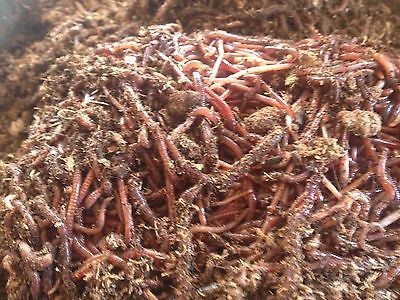Live red wigglers: How to begin composting
Wiki Article
Every Little Thing You Need to Understand About Red Wigglers for Composting
Red wigglers, or Eisenia fetida, play a pivotal duty in the world of composting, changing natural waste into valuable dirt amendments. The procedure of setting up a worm bin and preserving it can posture challenges.What Are Red Wigglers?

(Western North Carolina Bait) Belonging To North America, red wigglers are surface-dwelling organisms that favor wet, cozy environments rich in decomposing raw material. Their diet regimen consists largely of decaying plant material, food scraps, and various other natural debris, which they eat and damage down effectively. As they digest this product, they create nutrient-rich castings that improve dirt fertility.
Red wigglers are hermaphroditic, having both male and women reproductive body organs, and can recreate swiftly under optimum conditions. Overall, red wigglers are essential factors to the process of reusing organic waste into beneficial compost.
Benefits of Making Use Of Red Wigglers
Making use of red wigglers in composting systems offers various benefits that boost both the efficiency of waste administration and the high quality of the resulting garden compost. These worms, scientifically referred to as Eisenia fetida, are particularly reliable at damaging down organic issue, turning kitchen area scraps and yard waste into nutrient-rich compost at an increased price.One of the primary advantages of utilizing red wigglers is their ability to eat large quantities of natural product, typically processing their weight in food waste daily. This high consumption price brings about faster decomposition and minimizes the volume of waste sent out to land fills. Moreover, the castings produced by red wigglers are abundant in necessary nutrients, beneficial bacteria, and enzymes, making them an excellent plant food for yards and plants.
In addition, red wigglers thrive in a range of settings, making them adaptable for both interior and outdoor composting systems - red wigglers. Their existence in a garden compost bin aids to aerate the product, preventing odors and advertising a healthy composting process. Overall, utilizing red wigglers not just adds to reliable waste administration but additionally supports lasting gardening methods through the manufacturing of high-grade garden compost
(red worms for composting)
Establishing Up Your Worm Container
To successfully establish a worm bin, it is important to pick a suitable container that meets the needs of red wigglers while giving a favorable atmosphere for composting. A suitable container can be made from plastic, wood, or steel, with a capability of at least 1 square foot for every single pound hop over to here of worms.Make sure the container has adequate drain openings to avoid excess dampness, as red wigglers grow in a moist, yet not water logged, atmosphere. red wigglers. The bin must additionally be aerated to supply enough air flow, avoiding anaerobic conditions that might harm the worms
An ideal location for the worm container is a great, dark location, devoid of straight sunlight and severe temperatures, as red wigglers like a temperature level series of 55 to 77 levels Fahrenheit.
Prior to presenting the worms, prepare bed linens products such as shredded newspaper, cardboard, or coconut coir, which will give both environment and food. Dampen the bed linens gently to produce an inviting environment for the worms. Last but not least, take into consideration placing a cover on the container to keep humidity and lower pests, while ensuring it can be quickly removed for upkeep.
Feeding and Treatment Standards
Feeding red wigglers is a crucial element of keeping a healthy and balanced composting system. These worms thrive on a varied diet regimen, mainly composed of organic materials such as vegetables and fruit scraps, coffee premises, and crushed eggshells. It is important to prevent feeding them meat, milk, and oily foods, as these can create unpleasant odors and attract pests.When introducing food to your worm container, chop or shred materials into smaller pieces to facilitate quicker decomposition. Beginning with tiny amounts to determine the worms' consumption price, slowly raising the quantity as they adapt. It is suggested to alternate feeding areas within the container to urge thorough blending and aeration of the compost.

Troubleshooting Common Issues
Preserving a growing worm composting system can sometimes present difficulties that need attention and troubleshooting. Usual issues include an undesirable odor, which frequently suggests overfeeding or the visibility of anaerobic problems. To treat this, reduce the amount of food included and make certain correct aeration by blending the bed linens product.An additional constant problem is the retreat of worms from the bin. This can occur due to too much moisture or improper environmental conditions. Regularly inspect the wetness degrees, aiming for a damp but not soaked consistency, and keep optimum temperature levels in between 60-80 ° F(15-27 ° C )to create a comfy environment for your red wigglers.
Bugs, such as fruit flies, can additionally attack worm containers. red wigglers. To combat this, cover food scraps with a layer of bed linens or shredded paper to discourage flies from laying eggs. Additionally, guarantee that any food included is fresh and devoid of mold, which can bring in undesirable insects
Last but not least, if your worms appear non-active, inspect for tension factors such as temperature level variations or insufficient moisture. Resolving these common problems will aid preserve a healthy and balanced and productive worm composting system.
Final Thought
In summary, red wigglers, or Eisenia fetida, play an important function in lasting waste administration with vermicomposting. Correct arrangement and maintenance of a worm container, along with adherence to feeding standards, ensure a thriving ecosystem that decreases landfill payments.Report this wiki page